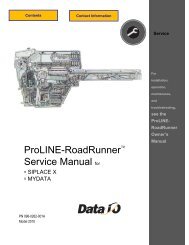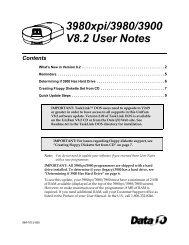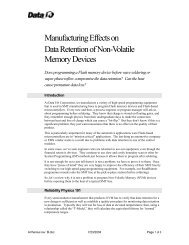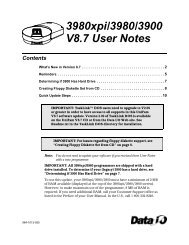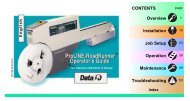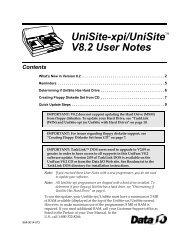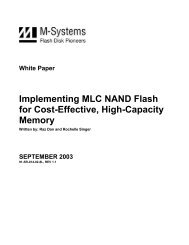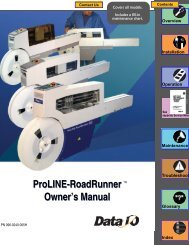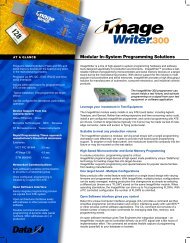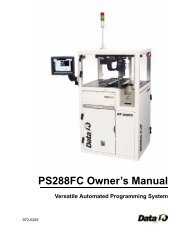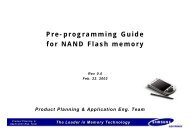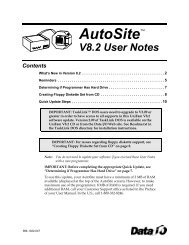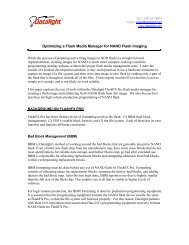Optimizing a Flash Media Manager for NAND Flash - Data I/O ...
Optimizing a Flash Media Manager for NAND Flash - Data I/O ...
Optimizing a Flash Media Manager for NAND Flash - Data I/O ...
You also want an ePaper? Increase the reach of your titles
YUMPU automatically turns print PDFs into web optimized ePapers that Google loves.
Tel: 1-800-221-6630<br />
Email: sales@datalight.com<br />
www.datalight.com<br />
<strong>Optimizing</strong> a <strong>Flash</strong> <strong>Media</strong> <strong>Manager</strong> <strong>for</strong> <strong>NAND</strong> <strong>Flash</strong> Imaging<br />
While the process of preparing and writing images to NOR flash is a straight-<strong>for</strong>ward<br />
implementation, creating images <strong>for</strong> <strong>NAND</strong> is much more complex, making a uni<strong>for</strong>m<br />
programming strategy arduous without the proper flash media management tools. Under the<br />
crunch of a product development schedule, it may seem practical to use a hardware simulator to<br />
capture an image of a file system, and then write that image to new flash by reading only a part of<br />
the flash that is thought to include all of the files. <strong>Flash</strong> experts would tell you that this is not as<br />
simple as it sounds, and is not likely to work reliably.<br />
This paper explores the use of tools within the <strong>Data</strong>light <strong>Flash</strong>FX Pro flash media manager <strong>for</strong><br />
creating a flash image and initializing fresh <strong>NAND</strong> flash from this image. We also discuss best<br />
practices <strong>for</strong> high volume production programming of <strong>NAND</strong> flash.<br />
BACKGROUND ON FLASHFX PRO<br />
<strong>Flash</strong>FX Pro has three distinct levels of <strong>for</strong>matting used on the flash: (1) BBM (bad block<br />
management), (2) VBF (variable block <strong>for</strong>mat), and (3) the file system. Each of these has its own<br />
function and imposes different constraints.<br />
Bad Block Management (BBM)<br />
BBM is <strong>Data</strong>light's method of working around the bad blocks that are generally present in <strong>NAND</strong><br />
flash. Even a brand new flash chip from the manufacturer may have some erase blocks that do not<br />
meet specifications <strong>for</strong> reliable data storage, and further blocks may go bad after extended use.<br />
BBM is responsible <strong>for</strong> allocating replacement blocks and remapping addresses from bad blocks<br />
to their corresponding replacement blocks.<br />
BBM <strong>for</strong>matting must be done be<strong>for</strong>e any use of <strong>NAND</strong> flash by <strong>Flash</strong>FX Pro. Formatting<br />
consists of allocating space <strong>for</strong> replacement blocks, scanning <strong>for</strong> factory bad blocks, and adding<br />
them to the bad block map. After this has been done, BBM reports a size that is slightly smaller<br />
than the full size of the flash chip. This smaller size is all that is visible to higher levels of<br />
software.<br />
For high volume production, the BBM <strong>for</strong>matting is done by production programming equipment.<br />
It is essential that the programming equipment <strong>for</strong>mats the <strong>NAND</strong> flash device exactly the same<br />
as <strong>Flash</strong>FX Pro, so that the file system will function properly. For this reason, <strong>Data</strong>light partners<br />
with <strong>Data</strong> I/O Corporation and ensures that <strong>Data</strong> I/O’s programming equipment correctly <strong>for</strong>mats<br />
<strong>NAND</strong> flash <strong>for</strong> <strong>Flash</strong>FX Pro.
<strong>Optimizing</strong> a <strong>Flash</strong> <strong>Media</strong> <strong>Manager</strong> <strong>for</strong> <strong>NAND</strong> <strong>Flash</strong> Imaging 2<br />
Variable Block Format (VBF)<br />
VBF is <strong>Data</strong>light's method of managing the allocation of flash to provide two essential features:<br />
small block emulation and wear leveling. File systems are designed to work on disk drives that<br />
can be written in small increments called sectors (typically 512 bytes), and can be rewritten<br />
repeatedly without affecting other data or decreasing the reliability of the disk. <strong>Flash</strong> memory is<br />
not directly usable by most file systems, as it must be erased in large increments called erase<br />
blocks (typically tens to hundreds of Kbytes) be<strong>for</strong>e being written, and each erase cycle causes<br />
wear that ultimately results in the failure of that erase block (typically after more than 100,000<br />
cycles).<br />
VBF overcomes these limitations of flash memory by storing data in flash memory at the next<br />
available location and building a map of where each allocation block (simulated disk sector) is<br />
located in the flash. A file system may write repeatedly to the same sector address, but VBF will<br />
store the data at a different location each time, marking the old copy invalid ("discarding" the<br />
allocation) after the new copy is written. Eventually the space occupied by the discarded data is<br />
reclaimed and erased <strong>for</strong> reuse. VBF tracks how many times each erase unit has been erased, and<br />
occasionally relocates static data from an infrequently erased unit to a unit that has been erased<br />
more frequently.<br />
VBF <strong>for</strong>matting involves writing an erase unit header (EUH) to each erase unit of the area of<br />
flash managed by VBF. Each time <strong>Flash</strong>FX Pro starts up, it reads the EUHs and associated<br />
allocation tables to build its map of what is where in the flash.<br />
In production, it is necessary that the programming equipment does the initial VBF <strong>for</strong>matting so<br />
that the image file can be properly written to the <strong>NAND</strong> device during the programming process.<br />
The File System<br />
File system <strong>for</strong>matting creates the initial data structures <strong>for</strong> a file system. Though <strong>Flash</strong>FX Pro<br />
can effectively communicate with any file system, the <strong>Data</strong>light Reliance transactional file<br />
system is recommended to be used with <strong>Flash</strong>FX Pro to achieve optimum device per<strong>for</strong>mance.<br />
Every file system has its own way of organizing files and directories. Reading and writing only a<br />
portion of a file system makes risky assumptions about where the file system stores its data on the<br />
disk.<br />
When working with a FAT file system, its File Allocation Table and root directory are fixed data<br />
structures that are guaranteed to be stored near the beginning of the disk. However, file data and<br />
subdirectories can be stored anywhere. While it is common <strong>for</strong> FAT file system implementations<br />
to start allocating space <strong>for</strong> new files near the beginning of the disk, as files are created and<br />
deleted they have a potential to end up anywhere, not just at the beginning. Thus there is no<br />
guarantee that reading only the beginning of the disk up to the total size of the files (plus some<br />
safety margin) will actually capture all of the desired data.
<strong>Optimizing</strong> a <strong>Flash</strong> <strong>Media</strong> <strong>Manager</strong> <strong>for</strong> <strong>NAND</strong> <strong>Flash</strong> Imaging 3<br />
Boot Loader<br />
FX Loader<br />
BBM<br />
<strong>Flash</strong>FX ® Pro<br />
VBF<br />
FMSL<br />
FIM<br />
<strong>Flash</strong> Memory<br />
File System<br />
Device Driver Logic<br />
Figure 1: <strong>Data</strong>light <strong>Flash</strong>FX Pro Block Diagram<br />
CREATING AND WRITING AN IMAGE TO FLASH<br />
Embedded Application<br />
Project<br />
Hooks<br />
Operating System<br />
OE Services<br />
CPU Layer<br />
OEM Hardware Plat<strong>for</strong>m<br />
For low volume applications, <strong>Flash</strong>FX Pro can be used to write an image to a <strong>NAND</strong> flash device<br />
“in-system”; <strong>for</strong> example, the image can be written to a <strong>NAND</strong> flash device in a new phone<br />
during development. For high volume applications, the <strong>NAND</strong> flash device is usually processed<br />
by high volume automated programming equipment be<strong>for</strong>e being soldered onto the PCB.<br />
However, in this case, <strong>Flash</strong>FX Pro is still needed to create the image by reading from the <strong>NAND</strong><br />
flash in a development system, <strong>for</strong> example.<br />
First, we will discuss using <strong>Flash</strong>FX Pro <strong>for</strong> low volume reading and writing. <strong>Flash</strong>FX Pro<br />
presents the flash as a simulated hard drive at the block device driver level. Capturing this “hard<br />
drive” image, and using it to initialize fresh flash, is unreliable as BBM, VBF and the file system<br />
<strong>for</strong>mats are not accounted <strong>for</strong> in this image. All of these data structures are required as <strong>Flash</strong>FX<br />
Pro does not necessarily do all of its writing near the beginning of the flash, even when it is<br />
freshly initialized.<br />
In order to capture the entire <strong>Flash</strong>FX Pro <strong>for</strong>mat, the functions to be used are oemread (to read<br />
the image) and oemwrite (to write it to fresh flash). Using this method, the image is guaranteed<br />
to work between devices whose flash arrays are similarly defined. The BBM reserved area will<br />
be created at the same location and size on the destination, as it was on the source. Any<br />
differences in bad blocks between the two physical flash arrays are handled transparently.
<strong>Optimizing</strong> a <strong>Flash</strong> <strong>Media</strong> <strong>Manager</strong> <strong>for</strong> <strong>NAND</strong> <strong>Flash</strong> Imaging 4<br />
Creating the Image<br />
In summary, creating the image should be per<strong>for</strong>med by linearly reading the raw sectors + the 16byte<br />
spare area. These steps are as follows:<br />
• Format the flash with the flash media manager and create the appropriate file system.<br />
• Populate the file system with the desired files.<br />
• Repeatedly compact the flash until the compaction function (vbfcompact, in <strong>Flash</strong>FX<br />
Pro) returns FALSE, indicating that nothing remains to be compacted.<br />
• Obtain the size of the accessible region of the flash. (Note that this size does not include<br />
the BBM region; this region will be recreated automatically by <strong>Flash</strong>FX Pro on the<br />
new flash.)<br />
• For each <strong>NAND</strong> page, call oemread (or similar function) and set it to read a total of 516<br />
bytes (512 bytes of user data plus four bytes of VBF allocation in<strong>for</strong>mation). Write this<br />
data to the image file. Do not per<strong>for</strong>m any file system operations on the flash drive while<br />
the image is being created.<br />
Writing the Image and Initializing Fresh <strong>Flash</strong><br />
Initializing fresh flash from the image file (as created above) should be per<strong>for</strong>med more or less as<br />
follows with <strong>Flash</strong>FX Pro:<br />
• Per<strong>for</strong>m initial BBM <strong>for</strong>matting. (There is no need to per<strong>for</strong>m VBF <strong>for</strong>matting, as the<br />
image contains the VBF <strong>for</strong>mat in<strong>for</strong>mation).<br />
• Obtain the size of the flash.<br />
• For each <strong>NAND</strong> page, read 516 bytes from the image file. Examine the data: if it is all<br />
ones, simply skip to the next page of flash without writing. Otherwise write it to the next<br />
page of flash using oemwrite. BBM will handle any bad blocks encountered during this<br />
process. Since much of the image file will contain pages that are all ones, it could be<br />
compressed using simple run-length encoding or some other scheme to avoid storing data<br />
<strong>for</strong> pages that are in their erased state.<br />
• The size of the file should match the size of the flash.<br />
• After the image has been written, mount the file system.<br />
Next, we will discuss high-volume duplication or programming of the image into new <strong>NAND</strong><br />
flash devices. Once the application is validated and a final image is created with the process<br />
mentioned above, the image is typically checked into configuration management. The process<br />
that we describe below assumes that the factory is using <strong>Data</strong> I/O’s RoadRunner programming<br />
equipment. The RoadRunner is an “on-line” programmer that mounts directly to an SMT feeder<br />
bank and programs the <strong>NAND</strong> flash devices on the SMT line. (This process avoids risk of having<br />
an inventory of pre-programmed flash devices in an application where frequent image (or code)<br />
changes occur.) We also assume that the manufacturing floor is using <strong>Data</strong> I/O’s TaskLink ®<br />
software application to create the “task” <strong>for</strong> the programming equipment. Here, a “task” refers to<br />
the binary file that contains instructions <strong>for</strong> the programming equipment, as well as the master<br />
image.
<strong>Optimizing</strong> a <strong>Flash</strong> <strong>Media</strong> <strong>Manager</strong> <strong>for</strong> <strong>NAND</strong> <strong>Flash</strong> Imaging 5<br />
The process is as follows:<br />
• Check the image out of configuration management.<br />
• Start the TaskLink application and create a new “task”.<br />
• In the Task Edit dialog box, select the <strong>NAND</strong> flash device from the list of supported<br />
devices.<br />
• Selecting any <strong>NAND</strong> flash device, will automatically invoke the Special Features dialog<br />
box; select a bad block handling type from the drop down list shown in Figure 2 below.<br />
For <strong>Flash</strong>FX Pro, use the bad-block method called “Skip Customer 1” as shown.<br />
Figure 2: TaskLink Special Feature dialog box.<br />
• In the <strong>Data</strong> dialog box, select the master image (from configuration management).<br />
• The last step is to “Create” a new task and download it to the PCMCIA card <strong>for</strong> insertion<br />
into the RoadRunner on the SMT line.
<strong>Optimizing</strong> a <strong>Flash</strong> <strong>Media</strong> <strong>Manager</strong> <strong>for</strong> <strong>NAND</strong> <strong>Flash</strong> Imaging 6<br />
At this point, you are ready to start high-volume programming of <strong>NAND</strong> flash devices on<br />
your production line, that are guaranteed to work with <strong>Data</strong>light’s Bad Block Management<br />
and Variable block <strong>for</strong>mat schemes.<br />
MAXIMIZING WRITE PERFORMANCE<br />
Per<strong>for</strong>mance gains can be expected during this image create/write process, with some additional<br />
planning:<br />
• Repeatedly compact the data on the flash be<strong>for</strong>e creating the image to ensure that all<br />
unused storage is erased.<br />
• When writing the image to a new phone, there is no need to program areas that are all<br />
ones; such areas may simply be skipped over. This way, the areas that need to be written<br />
are written, and all of the areas that can safely be skipped are skipped.<br />
This paper is authored by both <strong>Data</strong>light and <strong>Data</strong> I/O.<br />
About <strong>Data</strong>light:<br />
Bill Roman is a Software Architect at <strong>Data</strong>light.<br />
Since 1983, <strong>Data</strong>light's focus on portable, flexible solutions <strong>for</strong> embedded systems has enabled<br />
OEMs to save money, reduce development time and get to market faster. <strong>Data</strong>light has earned a<br />
reputation as a provider of reliable, compact and cost-effective data device management software<br />
solutions that are backed by a commitment to customer service and satisfaction. Through such<br />
features as OS portability, file system reliability and intelligent flash memory utilization, <strong>Data</strong>light<br />
ensures product quality in the rugged, unstable environments in which many embedded devices<br />
operate. For more in<strong>for</strong>mation, go to www.datalight.com.<br />
About <strong>Data</strong> I/O:<br />
Kelly Hirsch is the Chief Technologist at <strong>Data</strong> I/O Corporation.<br />
With more than 32 years of innovative leadership in the device programming industry, <strong>Data</strong> I/O<br />
Corporation® (NASDAQ: DAIO - News) provides manual and automated device programming<br />
systems that specifically address the requirements of engineering and manufacturing operations.<br />
<strong>Flash</strong>CORE is the architecture behind a family of <strong>Flash</strong> programmers that deliver the highest<br />
throughput and lowest cost per programmed device. <strong>Data</strong> I/O leads the industry in technology<br />
innovations <strong>for</strong> management and programming of <strong>NAND</strong> and NOR flash memories. <strong>Data</strong> I/O<br />
Corporation is headquartered in Redmond, Washington, and has sales and service offices<br />
worldwide. For more in<strong>for</strong>mation, see www.dataio.com or call 800-426-1045.<br />
©2006 <strong>Data</strong>light, Inc. All Right Reserved. <strong>Data</strong>light, the <strong>Data</strong>light logo and <strong>Flash</strong>FX Pro are trademarks or registered<br />
trademarks of <strong>Data</strong>light, Inc. All other product names are trademarks of their respective holders.




